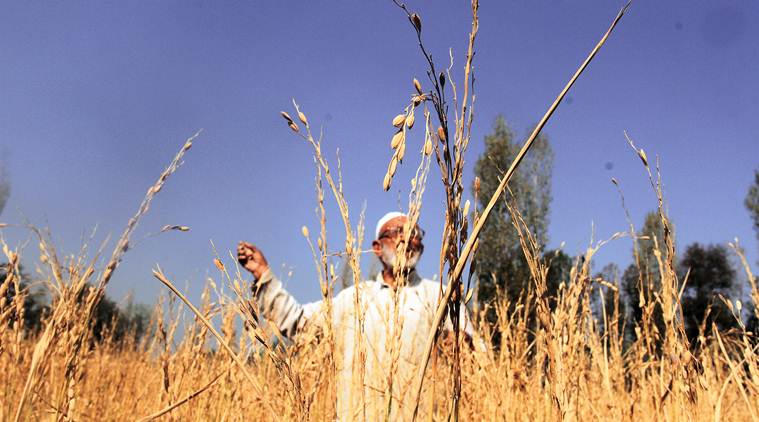 Paddy farmer Abdul Gani Teli at his two-acre field in Adina village of Kashmir’s Budgam district. (Photo: Shuaib Masoodi)
Paddy farmer Abdul Gani Teli at his two-acre field in Adina village of Kashmir’s Budgam district. (Photo: Shuaib Masoodi)
For over four months, Manzoor Ahmad toiled towards harvesting a bumper crop this season. But about two weeks ago, just when the 56-year-old’s paddy was getting ready for harvesting, a hailstorm damaged the standing crop at his four-acre land in Wata Magam, a village in central Kashmir’s Budgam district.
“The crop was looking good and I was expecting a total yield of 120 quintals, compared with last year’s 100 quintals. Those hopes are all dashed now (after the hailstorm),” said Ahmad. According to him, 90 per cent of his crop has suffered damage, even as he had taken a Rs 1.5 lakh loan at the time of sowing.
Ahmad is one of the many farmers affected by the hailstorm that swept through Budgam district on September 13 and 15. “There is no insurance for my crops. That Thursday, I waited anxiously for the hailstorm to end. When I reached my fields, there was practically no crop left. Government officials came for assessment the next day, but I have received no compensation so far,” he noted.
In the nearby village of Adina, the family members of Abdul Gani Teli, 78, began harvesting paddy in their two-acre land last week. “There was only grass and no crop at all. The only time I saw this kind of destruction was in 1965, when we had untimely snowfall,” claimed this farmer, who cultivates 11 kanals (1.3 acres).
Crop losses may be integral to farming, but Ahmad and Teli are doubly unfortunate in having no insurance cover either. The Centre’s yield-linked Pradhan Mantri Fasal Bima Yojana (PMFBY) and the restructured Weather-based Crop Insurance Scheme were rolled out during the 2016 kharif season across India. But these flagship agricultural insurance schemes are yet to be implemented in the Kashmir valley, even while some 87,000 farmers in the Jammu region’s 10 districts have been covered.
The PMFBY is supposed to compensate farmers for yield shortfalls (relative to seven-year average threshold levels for the particular tehsil/block), while weather-based insurance indemnifies against adverse weather events (in terms of deficit/excess rainfall, high/low temperatures and other measurable parameters) during the cropping period. In PMFBY, post-harvest losses are also covered, which is not the case with the weather-based scheme.
Farmers in both Wata Magam and Adina villages have reported near-total damage to their paddy crop this time. This is also confirmed by data provided by the Department of Agriculture Kashmir. As per this, the two severe hailstorm incidents of September 13 and 15 caused complete crop loss on 4,509.6 hectares of paddy, 236.7 hectares of maize and 358.65 hectares of vegetables in the two villages, affecting 19,483 families.
“At present, there is no insurance scheme. So, all that we could do is send a report detailing the damage and seek compensation from the authorities,” admitted Shabir Ahmad Allaqband, Chief Agriculture Officer of Budgam.
The reason for the PMFBY being a non-starter in the Valley is the higher premium charges quoted by insurance companies. The J&K government, in turn, sought to negotiate lower rates, which are, however, not acceptable to the insurance firms. “They have informed us that the premium rates we are offering are not tenable compared to the risks of operating here. We floated tenders eight times, but the rates quoted have been far too high,” Syed Altaf Aijaz Andrabi, Director of the Department of Agriculture Kashmir, told The Indian Express.
Paddy is grown in about 1.4 lakh hectares area in the Kashmir valley, with an annual production of nine lakh tonnes. With no insurance facility, farmers bear the brunt of crop failure. “PMFBY was introduced in Jammu & Kashmir from kharif 2016-17. But it has been implemented only in the Jammu division, where, in the 2017-18 kharif season alone, Rs 579.61 lakh was provided as compensation to 13,762 beneficiaries. Bids have been called in the state since 2016. But even in the last tender, the four companies that bid quoted rates only for the Jammu region,” Suhail Inamullah, Technical Officer to Director Agriculture Kashmir said.
There was meeting held with the CEOs of the empaneled insurance firms in New Delhi last March to allay apprehension about operating in the Kashmir Valley, “but the premium quotes offered by them were too high and we did not approve the rates,” said a department official.
Horticulture farmers, too, are hamstrung by the absence of insurance. “There should be a scheme to protect growers, especially against yield losses at the end of the season due to hailstorm and other natural calamities,” pointed out Fayaz Ahmad Malik, president of Fruit Association in North Kashmir’s Sopore, the Valley’s fruit bowl.
So, what’s the solution?
Andrabi held out the hope of “tweaking” bid processes under PMFBY, to make it more attractive for insurance companies. For annual horticultural and commercial crops such as apple and saffron (in Kashmir) and mango (in Jammu), it is proposed to implement the weather-based insurance scheme. But the problem here is crop-cutting experiments (CCE), which was used to determine threshold yields and pay-offs in the event of yield losses.
“The CCE module for apple, saffron and mango are yet to be firmed up at the national level. At the same time, the insurance companies have not accepted the CCE modules developed by us for these crops,” the official stated.
In the meantime, the Kashmir paddy farmer and apple grower will be entirely at nature’s mercy and have to manage without crop insurance.